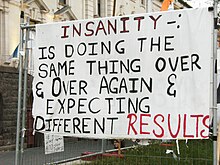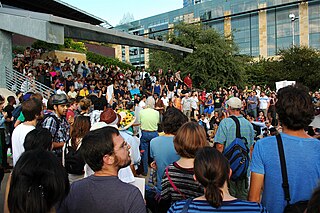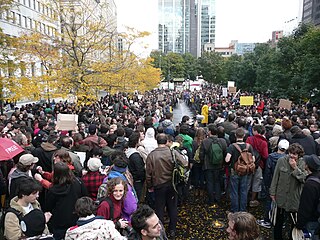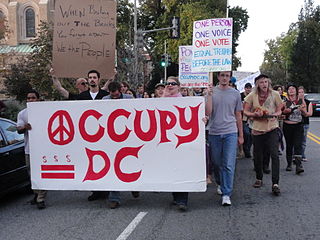On 3 November 2011, the Declaration of the Occupation of Auckland was ratified. This statement, which was workshopped heavily for 10 days, was addressed to the people of New Zealand, though it was understood that it would be read widely in government circles throughout the country. It was intended to express the justification of the Occupiers for their actions, "We wish you to hear those concerns which have driven us to make this Occupation. We do not do this lightly. For we live with the risk of arrest. We have put our reputations, our persons, our careers, our property and our relationships in jeopardy. We wish to impress upon you the depths of our determination and our sincerity."
The declaration was not intended to be a policy statement or political platform, though it does explain the purpose of the Occupation. It consists of an introduction, in the form of a Preamble, a list of formal Grievances, and a Call to Action, requesting the reader to judge for themselves whether the Occupiers are justified in their actions. Three choices of response were offered; to join, to support or to fight the Occupiers. The declaration concluded by appealing for the reader to come and help the Occupiers by reasoning together to discover solutions for the benefit of all New Zealanders. The Occupiers then declared a challenge, declaring that they would remain in the Square "until the 99% awaken".
The declaration was received enthusiastically by the Occupiers and was ratified unanimously. Five days after it was ratified, it was printed and laminated on A0 and posted on three sides of the Occupation. Most visitors were observed to read it in its entirety.
In the weeks that followed its ratification, criticisms of the declaration began to emerge, though there was no serious or concerted attack on the document, and support remained strong. A few persons outside of the Occupation felt that key issues were not represented, pertaining particularly to indigenous rights and ecological concerns. Others felt that it was difficult to read. It was also criticised as being "too American", because of its resemblance to the OWS Declaration and its echoing of sentiments found in the Declaration of Independence. Its strong language and unambivalent tone and its enumeration of grievances rather than political solutions was considered to be out of character with other more traditional New Zealand political statements. However, when the grievances are removed, parallels between the Declaration and the Declaration of the Independence of New Zealand can be observed. Similarities between the two documents include the citation of the authority of the framers and the strong reference to logical assertion of sovereignty, a common theme in populist political thought in New Zealand. The author of the Auckland Declaration was unaware of the New Zealand Declaration of Independence at the time, and so these similarities are best attributed to the familiarity of both authors with the common roots of Western political democracy.
TO THE PEOPLE OF AUCKLAND AND NEW ZEALAND; we the Citizens and Residents in Occupation in Aotea Square wish to communicate a few of our grievances, space being limited, so that you may judge for yourselves whether we are right in our cause.
There is much that is excellent and good about our country. But we are not Subjects who must go quietly and obey. We are free and proud New Zealanders and people of Aotearoa. It is required that our government answer to our Collective Voice. Not when it suits them, once every three years, but whenever the General Will of the People is made known, no matter how that may occur.
We wish you to hear those concerns which have driven us to make this Occupation. We do not do this lightly. For we live with the risk of arrest. We have put our reputations, our persons, our careers, our property and our relationships in jeopardy. We wish to impress upon you the depths of our determination and our sincerity.
Consequently, in Solidarity with all other peaceful Occupiers around the world, we declare;
It is unacceptable to us that 1% of the population should own and control a disproportionate amount of the wealth of our country. We find such greed and injustice abhorrent, as is the suffering it causes our people.
We resent that we, the 99% should pay for the greed and the folly of this 1%. We reject out of hand the austerity measures our politicians are preparing to saddle us with.
We can have no sympathy for the rich while more than 200,000 of our children live every day in hopeless poverty. There can be no peace for the 1% while our children suffer and go to bed hungry.
We also decry the shameless exploitation and manipulation of our young people for profit by companies selling them unhealthy foods and debilitating products. It must stop. As parents, we are aggrieved that our children's health and well-being is threatened by these outside influences beyond our ability to control.
Nor will we accept that our elderly parents, who worked and paid taxes all of their lives, should now live in fear that their pensions and their access to quality medical care should be threatened.
We repudiate the policy whereby all young New Zealanders must now pay for a University education which past generations received for free; the quality of our democracy is dependent upon the universal education of its citizenry.
We denounce the practice whereby young people are expected to work for nothing as Interns, or languish in dead-end jobs because companies refuse to pay for vocational training.
It is a scandal that our young families cannot afford to buy a home, and that devious lenders are allowed to trap them in a lifetime of debt slavery.
We refuse to accept the artificially high levels of unemployment and reduced working conditions which have been forced upon us by the Architects of Globalisation.
We also denounce the destructive, systemic undermining of our economic self-sufficiency, the flooding of our local markets with cheap goods from overseas at the expense of local producers, the irrevocable sale to faceless foreign corporations of our precious lands and resources, and the shameless lack of social conscience exhibited by some of our companies.
Finally, and most grievously, we abhor the disproportionate control of our political institutions and our media by the 1%. For from this one malignant tendency, a multitude of injustices proceed. We therefore state as a governing principle that as companies and corporations are not natural persons, they shall not be entitled to protection under our Bill of Rights, and they may not act to influence our political processes for their own ends.
We, the Citizens and Residents occupying Aotea Square call on you to consider our grievances and respond in whatever way your Reason and your Conscience dictates.
If it is to join us, then join us. If it is to support us, support us. But if it is to fight us, then come not with ignorant insults, or force of arms to do violence on account of petty regulations. Come instead to right the injustices we protest, and we will gladly welcome you.
Come reason with us. Come add your voice to ours. Come help us find a better way.
The old ideas, the old systems, the old ways of thinking have set our society on an unsustainable path. We need to set a new course that insures us and our children a future.
We are here, and here we stay, till we have finally roused the 99% from its long and troubled slumber.
In Solidarity, The General Assembly of the Occupation of Auckland.
















